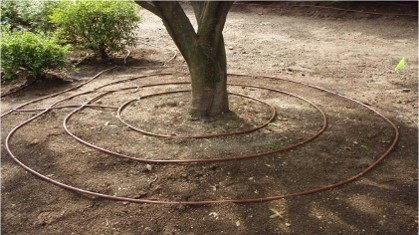








Iterations are fine, we don't have to be perfect
My 2nd Location:Florida HardinessZone:10 AHS:10 GDD:8500 Rainfall:2in/mth winter, 8in/mth summer, Soil:Sand pH8 Flat
 2
2








S Bengi wrote:Can you post a layout of your site. Size, elevation, etc plays a huge part. When in doubt give too much info.
Lets say I had 20 rows of trees each with 10 trees.
I would give each row their own independent line.
I would then have each of 20 lines connecting connecting to a main line on the right.
I would then have another main line on the left to equalize the pressure.
I would put a switch at each end of every row so that I can independently work on each line.




Garden Jennie wrote:The local nursery owner recommended emitters ( I use flag emitters) directly punched into your mainline (I have 1/2” and 3/4” tubing). Attach 1/4” tubing to the emitter thus you can move the location of the water delivery as the tree grows. I have three emitters per tree. The length of the 1/4” tubing ranges from 8” to 30”. The flag emitters can swivel around. This does not follow the instructions that come with some emitters. This is what he uses at the nursery to water potted trees but with the barrel style emitter.







Iterations are fine, we don't have to be perfect
My 2nd Location:Florida HardinessZone:10 AHS:10 GDD:8500 Rainfall:2in/mth winter, 8in/mth summer, Soil:Sand pH8 Flat







Iterations are fine, we don't have to be perfect
My 2nd Location:Florida HardinessZone:10 AHS:10 GDD:8500 Rainfall:2in/mth winter, 8in/mth summer, Soil:Sand pH8 Flat




 2
2




Antonio Scotti wrote:
Garden Jennie wrote:The local nursery owner recommended emitters ( I use flag emitters) directly punched into your mainline (I have 1/2” and 3/4” tubing). Attach 1/4” tubing to the emitter thus you can move the location of the water delivery as the tree grows. I have three emitters per tree. The length of the 1/4” tubing ranges from 8” to 30”. The flag emitters can swivel around. This does not follow the instructions that come with some emitters. This is what he uses at the nursery to water potted trees but with the barrel style emitter.
So are you saying that for each tree row, you have one blind pipepline and in correspondence of the tree location you punch 3 1/4" tubing with an attached flag emitter at the end, and that's it?
And what about when the tree canopy becomes 16' wide? Would you continue using the same system, only with longer tubings + flag emitters and more of them?
Thanks





Some places need to be wild




Eric Hanson wrote:Antonio,
a lot of orchards just lay them down and forget about them).
Eric
Personally I would use the lowest flow necessary—.5 gallons/hour.










 1
1




Some places need to be wild














 1
1




Some places need to be wild

|
Danger, 10,000 volts, very electric .... tiny ad:
Play Your Way to a Sustainable Lifestyle: Uncover Permaculture Principles with Each Card
https://gardener-gift.com/
|





